When considering the reuse of canning lids, there’s little research supporting their safety. However, the canning shortage of 2020 provoked a lot of experienced canners to share their wisdom, experience, and success with unorthodox methods.
Their findings have had a significant impact on the canning community even though their methods aren’t supported by governing agencies.
Setting the Record Straight
Many concerns about canning exist, especially with novice canners lacking knowledge and experience. The dangers of botulism are so stressed within the industry that it downright scares many people away from canning altogether.
There’s a misconception that if government agencies haven’t approved something, it must be dangerous. With canning, this isn’t necessarily the case. It simply means that sufficient testing hasn’t been done to verify the safety of a certain product or process.
Not testing something is not the same as being dangerous. By no means am I condoning anything that goes against the USDA or the National Center for Home Food Preservation (NCHFP).
However, let’s clarify common misconceptions about an often muddy subject.
There’s no direct danger to your food if your jars don’t seal. You either eat it, reprocess it, or preserve it differently. The dangers in canning come from false seals that are almost always associated with improper processing or not following your recipe:
- Over- or underfilling the jar
- Not removing air bubbles
- Dirty jar rims
- Inaccurate temperatures
- Incorrect processing times
- Poor quality jars and lids (knock-off brands)
- Tightening lids too tight
False Assumptions
Failing to follow a recipe or processing times to the letter can create a false seal. This allows airborne microorganisms to grow in your food, increasing the risks of foodborne illnesses, including botulism.
Because of the taboo surrounding used canning lids, some people assume a false seal is more apt to occur. However, notice in the link provided above there is no mention of any relationship to new or used lids.
The truth is the research doesn’t exist. While anecdotal evidence shows increased seal failures, there’s no evidence supporting an increase in false seals. Likewise, false seals can just as easily occur with new lids.
We know three things with absolute certainty:
- Governing authorities don’t condone reusing lids.
- People do it anyway.
- They live to tell about it.
Only you can weigh the evidence and determine for yourself if it’s worth the risk.
Types of Canning Lids
For the most part, reusing canning lids depends on the type of lid in question.
Traditional Canning Lids
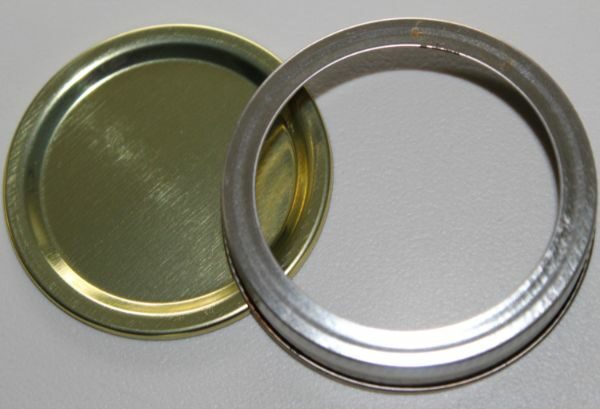
A traditional canning lid consists of two separate pieces: a flat metal disc and a screw-on band. Manufacturers design these seals for one-time use, and it’s the only lid approved by the USDA and NCHFP within the United States.
These lids have a sealing compound around the perimeter of the lid that softens as it is heated. That compound adheres itself to the lip of the jar, creating a vacuum seal. The vacuum process creates an indentation in the compound.
Many people advocate reusing these lids for canning and have successfully done so for several years. However, all these agencies recommend new canning lids with each attempt:
- NCHFP
- USDA
- Every ag extension across the country
- Lid manufacturers
There are fewer than 30 cases of food-borne botulism annually without any mention of home canning as the cause. That’s not to say it’s impossible, of course, but reused canning lids were not listed among the sources.
Logically, it makes sense that you can reuse lids, but you’re doing so at your own risk and against manufacturer and authoritative recommendations. Reusing your lids does contribute to increased seal failures, which is not the same as a false seal.
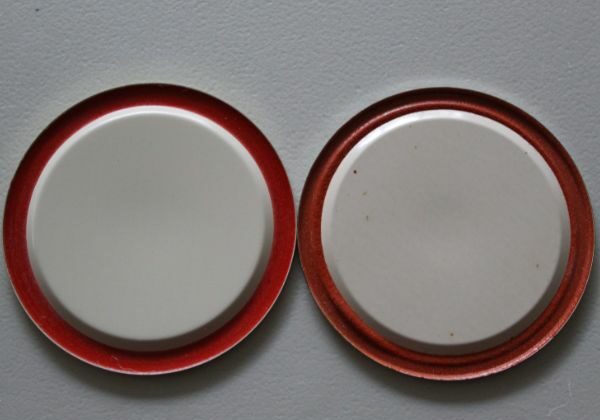
For this reason, many canners choose new lids because it’s less of a hassle. It’s also worth noting that few canners reuse canning lids when pressure canning is involved. Low-acidic foods are already more at risk for foodborne illnesses, so many just feel it’s safer to stick with new lids.
You can reuse the bands indefinitely as long as they remain free from bending, dents, or rust. Once your canning process is complete, be sure to remove the bands.
Reusable Canning Lids
Reusable, or three-piece lids, made a popular surge during recent supply shortages when standard canning lids were hard to come by. As the name implies, manufacturers like Tattle and Harvest Guard designed them for repeat usage.
They come with a plastic top and rubber gasket affixed by a traditional metal band. Some canners even use these rubber gaskets with their used metal lids instead of plastic discs.
There have been many reports that seal failures are substantially higher with these lids compared with traditional metal lids. However, many experienced canners attribute this to user error due to subtle differences in lid application.
The rubber gaskets eventually wear out and need to be replaced but are reusable as long as they’re in good condition. Do not attempt to use them if you see any signs of dry rot or tearing.
It should be noted that while many canners use and endorse reusable canning lids, they have not yet been endorsed by governing agencies.
One-Piece Canning Lids
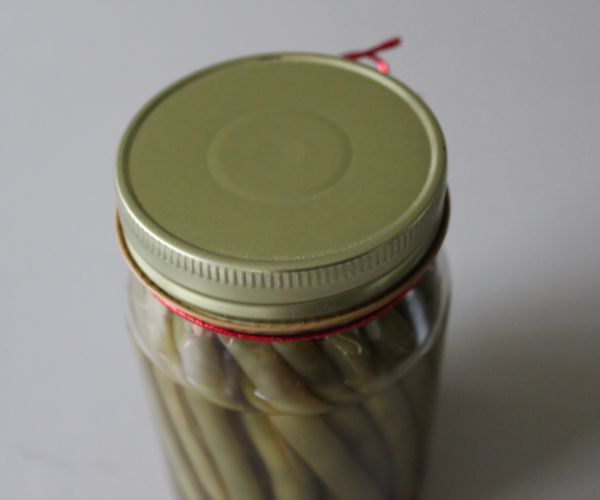
One-piece, zinc-style canning lids carry a bit of controversy and, again, lack sufficient research. Their use in home canning depends on where you live and who you trust.
Most extensions recommend not using one-piece canning lids at all. However, many people do because they’re cheaper. In some parts of the world, it’s either the only thing available or the only affordable option.
Many argue against one-piece lids for several reasons:
- They don’t allow oxygen to escape.
- They are more prone to corrosion.
- They don’t seal as well.
- You cannot check the integrity of the hermetic seal without opening the jar.
If you must use one-piece lids, use ones that are lined with plastisol and have a center button. The center button gives you a visual indication of a successful seal (albeit subjective).
Even though it goes against the guidelines, people still find success using these lids for both water bath and pressure canning. However, many canners report increased difficulty getting these lids to seal at all.
Since most canners don’t like using these lids once, there’s little support for using them twice.
The one concern I have with one-piece lids is the inability to recognize false seals.
With traditional lids, when food is improperly processed, air can expand and pop the lid off your jar, letting you know the food is unsafe to eat.
Because these lids are screwed on, they won’t be able to pop off. This might mask any harmful microorganisms present.
Minutes 3:47 through 6:07 of this video give you a thorough understanding of what I mean.
Otherwise, they’re great for dry storage items and can be used endlessly for any of those options.
One-Piece Zinc Porcelain Lids
Some canners still use vintage zinc lids that have a porcelain underside. The process is very similar to Weck jars except the lids screw on. During the canning process, the lid adheres itself to a rubber gasket that rests around the shoulder of the jar.
Since they’re vintage, they’re not easily accessible, but you can still find them on sites like Etsy and eBay. A proper seal is evident when the center of the lid is concave.
Because the gasket must be torn off to open the jar, you cannot reuse it. When sealed properly, you should be able to hear hissing air when opening the jar. While the gaskets aren’t reusable, the lids are.
Weck Jars and Lids
Weck jars are the standard in many countries outside the United States and consist of a glass jar and lid, rubber gasket, and metal clamps for holding the lid in place. They are used both for water bath canning and pressure canning.
While the US doesn’t approve of Weck jars, sufficient research suggests they are indeed safe for canning and have been successfully used in other countries for decades. Even the rubber seals are deemed reusable.
The gasket has a rubber tab that will point downward, providing you with a visual indication of a proper seal. Unlike traditional lids, you can stack Weck jars because the downward tab lets you know if the seal breaks.
Fowler Vacola Lids
Vacola jars are similar to Weck jars, except they use a tin lid instead of glass. A spring clip covers the full diameter of the lid, holding it in place over the gasket. Vacola jars are traditionally used for water-bath canning only.
Fowler condones repeated use of the tin lids indefinitely but claims you should only use the rubber rings once. This hasn’t stopped canners from reusing the rubber gaskets.
Once the canning process is finished, the spring clip should be removed before storing jars so the lid will pop off if the seal breaks.
Wire Bailing Jars
Wire bail jars were the predominant choice during the early years of the 20th century, and many canners continue to use them today for both water and pressure canning. Do not confuse these jars with modern-day wire bail jars used for dry storage.
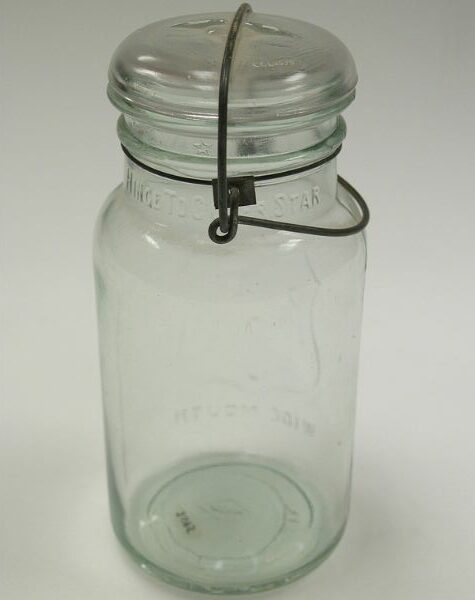
The process of using wire bail jars is almost identical to Weck jars. The only difference is that wire bails have their own fastening mechanism. Just like Weck jars, the rubber seals are reusable as long as they remain in good working order.
Once the canning process is complete, remove the wire bail and attempt to lift the lid. The jar is adequately sealed if the lid remains in place. Store them with the wire off, so the lids can pop off if the seal breaks.
Commercial Lids and Jars
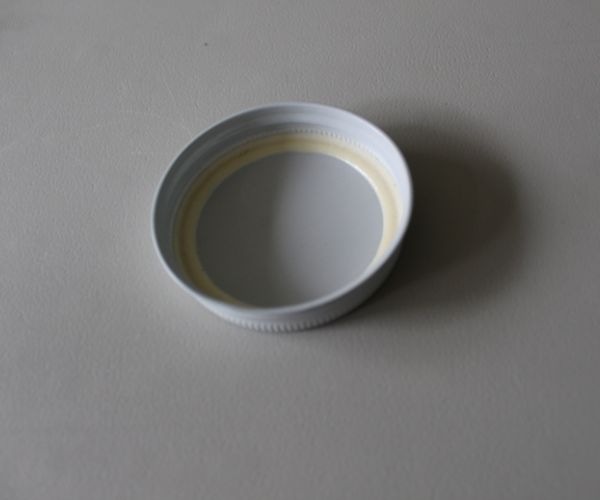
Going outside of authoritative recommendations is a very controversial subject within the canning community, but the topic exists nonetheless.
Even the National Center for Home Food Preservation condones the use of some commercial jars but, again, limits the lids to traditional two-piece metal lids.
Some canners use commercial jars and lids anyway without reservation. For commercial lids, check the underside. If the inside of the lid has a rubber seal in good working condition, feel free to reuse it.
The size of the jar is the one thing that poses a risk when repurposing commercial jars.
Canning recipes should be followed to the letter because they have been tested and approved by the NCFHP. Typically, written recipes call for pint or quart jars (at least in the US). Using a different-sized jar can change the temperature of the contents as well as the necessary processing time.
It’s important to know the majority of canners only repurpose these jars for water-bath canning, fermenting, or pickling. When it comes to low-acidic foods, a good majority of canners stick with regulating guidelines. They use new traditional lids, Weck jars, or wire bailing jars because they have a proven history of success.
Since not all commercial jars are safe for canning, check the bottom for braille-like dots. If you can see or feel perforations around the circumference of the jar then it’s generally safe for canning.
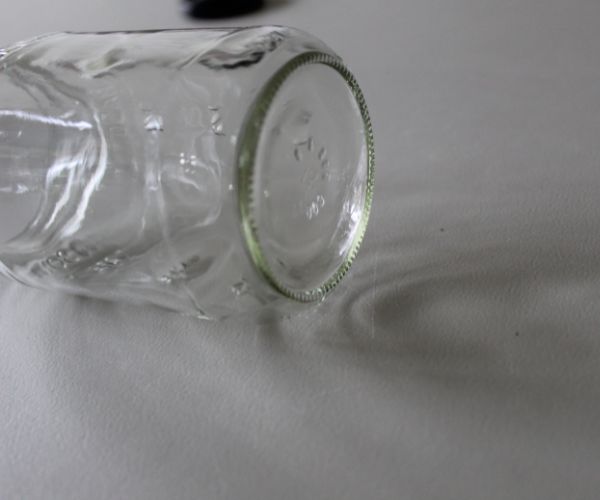
Bear in mind what you can do and what you should do aren’t always the same thing. Even though governing authorities don’t condone their use, sufficient evidence reveals the successful reuse of canning lids in some situations.
Even if you never use any of these techniques, at least the knowledge offers some reassurance that you can if you absolutely must.
Image Credits
Auckland Museum, CC BY 4.0, via Wikimedia Commons




I have been saving lids from various store bought canned foods – peanut butter, pasta sauce, pickles, etc – those that fit my canning jars, so I can use those jars again for foodstuffs but not for re-canning. Left overs, dehydrated foods I make, etc.. The problem is I have not found a way to get the smell out of the used lids. I have long soaked, multiple washings, even boiled them to no avail. All lids I save are the metal type with the rubber ring permanent in them. Do you know how to get the smell out of used lids?
Soaking in baking soda (without water) is usually the best option.
Milton / Baby bottle sterilisation fluid works for me with water leave for 10 minutes + and it’s no longer smelling of vinegar/pickles and will often get rid of stubborn stains too.